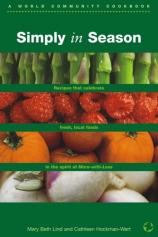Simply in Season: Recipes That Celebrate Fresh, Local Foods in the Spirit of More-With-Less
Review
Simply in Season: Recipes That Celebrate Fresh, Local Foods in the Spirit of More-With-Less
I've always liked the idea of living more simply. My copy of the Mennonites' MORE-WITH-LESS COOKBOOK that I've cooked with for more than 25 years is tattered and a little burned on the edges. (Note to self: don't leave your cookbook close to a burner). So I was delighted to see Herald Press add SIMPLY IN SEASON to their cookbook line. It offers a diverse selection of interesting recipes while helping raise awareness of eating more responsibly.
The focus is to eat simply. Eat a diversity of food. Eat foods that are in season. Why? It's better for us, the economy…and better for the Earth.
I live in the Chicago suburbs, where my pocket handkerchief-sized yard and small vegetable garden means I buy most of my produce and all of my meat from the supermarkets. I'm always dithering. Should I buy organic? Family farm-produced? Is the cheapest chicken the best buy? With this in mind, I found that the best portion of the cookbook were the short essays sprinkled through the pages that urge readers to think carefully about their food choices. What is genetically-modified food? How can we eat more locally? What does it look like to use food to build community?
SIMPLY IN SEASON answers these questions and more. It offers both practical steps and short inspiring testimonials that will help us think more about our grocery shopping. Support locally-owned grocery stores, restaurants and cooperatives. Buy fairly traded coffee, chocolate, and tea. If you garden, share vegetables with a neighbor. Participate in a community kitchen program in which groups cook meals together, saving money and time.
The comb-bound cookbook is formatted in five sections: Spring, Summer, Autumn, Winter, and All Seasons. Each recipe in a particular section highlights one or more vegetables or herbs associated with that season. The measurements are given in both American units (cups) and metric (milliliters). Some recipes give both baking and microwave directions.
If you do much cooking, you'll find some familiar favorites; from Apple Cake to Stuffed Zucchini. I discovered that Autumn's cold Broccoli Salad (with its note - "This recipe is known to turn broccoli-haters into broccoli-lovers") is mostly identical to the one my husband's mom makes for family gatherings. It's delicious!
More unusual produce makes appearances. I was delighted to find three summer recipes to help me make the most of my backyard okra crop (Okra Curry, Fried Okra, Okra Saute). Another pleasant surprise was two regional recipes for south Indiana's persimmons (a smaller and more astringent fruit than the Asian ones you find in the grocery store). My grandmother, a native Hoosier, made a persimmon pudding every fall and I took up the mantle of baking it after she died. Most cooks won't have access to this particular fruit, but can find canned pulp through various outlets on the Internet (the recipe might have benefited from an endnote here).
There's also some international recipes, including Rösti, a Swiss-inspired potato dish, and the Middle Eastern-style Turkey Lentil Pilaf. If you like more of this sort of cooking, you might check out Herald Press's EXTENDING THE TABLE, which focuses on ethnic recipes and sharing resources with the global community.
I chose two recipes to test with my family, both from the winter section. The Au Gratin Cabbage looks beautiful in the pan, although after the first bite, both teens left a lot on their plates ("too strong"). Unless your family is wild about cabbage, skip this one. Our dessert test of Spicy Baked Apples fared much better, although I realized I had used a tablespoon of cinnamon instead of a teaspoon when I took the first bite (make that "VERY Spicy Baked Apples!"). Use the brown sugar instead of the maple syrup for a sweeter taste. Delicious.
Only a few technical troubles have cropped up as I've used the cookbook. Occasionally, the index doesn't work ("rhubarb" sends you to the Four Fruit Crisp on page 149, but there's no rhubarb to be found). More unusual ingredients could benefit from definition and description (kombu seaweed?) and ideas on where to purchase (the persimmons). There's some good supplementary information on such things as tempeh and seitan in a short section on "Alternative Proteins" on 340.)
Rich, four-color graphics, a terrific layout, and color-coded page edging (to help you find your seasonal recipes quickly) make this book a better visual treat than MORE-WITH-LESS. I found the "key ingredient" index helpful (if you have a bumper crop of kale and don't know what to do with it, or a leftover bag of carrots that need using). Likewise, the "index to writings" section helps you locate topics of interest (cooperatives, fair trade food, stewardship). The comb binding seems stronger than my ancient MORE-WITH-LESS's spiral treatment, which has suffered over these 25 years. (There's also a paperback edition that's less expensive). I won't quit using MORE-WITH-LESS, but I'm looking forward to another 25 years supplementing it with SIMPLY IN SEASON.
Reviewed by Cindy Crosby on June 30, 2005



